What do we know about Mars?

On the occasion of the fourth anniversary of the landing of the rover Curiosity talk about modern knowledge of Mars.
Planet Shelezyaka: no water, no minerals, populated by robots ... ". It looks like Mars, but only the point coincides with the robots, the rest is there, although not as much as on Earth. What about Mars is well known? The fourth planet from the sun. Less Earth, more Mercury. Olympus Volcano is the largest mountain in the Solar System, it is also the largest volcano. The Mariner Valley is the largest canyon in the Solar System, which is hundreds of times larger than the largest canyon on Earth.

')
Global dust storms. Sparse carbon dioxide atmosphere. Auburn color due to iron oxides covering the surface. I think this is the minimum that the vast majority of the inhabitants of the planet Earth know or should know about the neighboring planet.
However, the study of Mars continues, new facts and discoveries are announced regularly at virtually every planetological scientific conference. Let's try to update our knowledge by adding them freshness and fullness.
Let's start with the atmosphere. Despite its rarefaction, the atmosphere is the most "live" part of Mars, in which there are many interesting processes. The density of the atmosphere of Mars is on average 1 / 125th of the density of the Earth’s atmosphere. At the same time, its thickness is slightly less than that of the Earth’s atmosphere - this is due to the lower force of attraction. Therefore, research satellites of earthlings are forced to fly at altitudes greater than 250 km so that the atmosphere does not have a significant impact on the orbit.
Global Martian dust storms are irregular and occur about once every 6 Earth years. At the same time, each Martian year, the atmosphere undergoes large-scale evaporation processes of the carbon dioxide polar cap in the summer hemisphere and the freezing of the same cap at the winter pole of the planet. Up to a quarter of the total mass of the atmosphere participates in such a transfer.
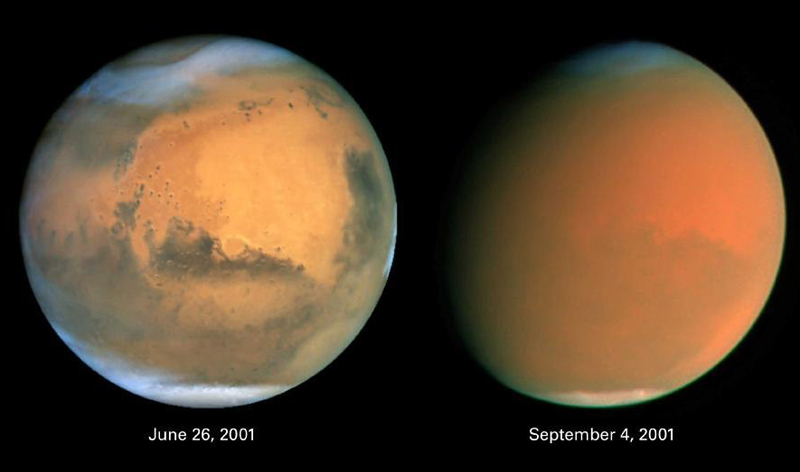
Such dynamics gives rise to local storms, which are frequent at the poles, but rather rarely reach the equator. For example, the Curiosity rover, operating 5 degrees south of the equator, only once for two days was in the dust that limited visibility to ten kilometers. At other times, visibility is maintained up to 40 km, and during some quiet winter weeks you can see mountain peaks at a distance of 80 km.
Almost at any time of the year, red dust hangs in the atmosphere of Mars, although its concentration varies depending on the season. The most "dusty" times are autumn and spring, when the atmosphere is pumped from one pole to another. At this time, the sky color is orange-beige up to brown during storms. In calm months, the dust settles, the zenith blackens, and the beige color of the sky descends to the horizon. At such times it is possible to observe bluish shades of the sky, when the sun approaches the horizon and atmospheric gases manage to slightly disperse the blue component of the solar spectrum.
In addition to large-scale dust storms covering the entire planet or its essential parts, on Mars you can observe the activity of small eddies, which American scientists call Dust Devil. Most often they look like a dusty trunk, rising to a height of several meters to several hundred meters.

Dust Devil can be invisible. For example, the Curiosity atmospheric pressure sensors repeatedly recorded the passage of a small whirlwind on the device, while the cameras could not even remove such a whirlwind, although attempts are being made regularly. But Opportunity periodically manages to see small whirlwinds, which at the same time help to clean its solar panels from dust.

Due to frequent dust storms, someone may form the impression that Mars is simply filled with dust to the eye, which makes it impossible to study its in situ geology directly on the spot. The seven centimeter drill of the last rover is surprising to many for its short length. Dust, of course, covers on Mars all the space where the wind can reach, but the thickness of the dust layer sometimes does not exceed a fraction of a millimeter. The process of atmospheric erosion on Mars is still ongoing, it contributes to an increase in dust volumes, but the surface areas exposed to erosion are bare. In one of these places, Curiosity works.
A good argument in favor of low intensity deposition of weathering products is the example of parachutes of the landing modules of automatic space stations of the last century. In 2012, the Mars-3 parachute was found (1971 landing), and then the device itself.
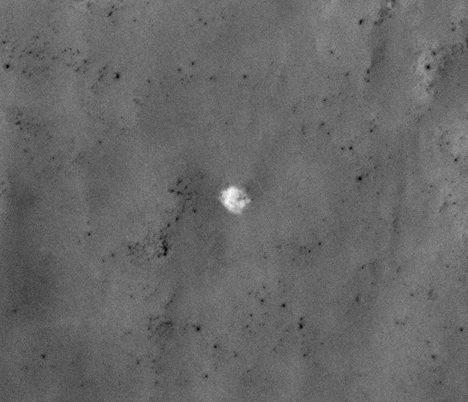
The parachutes of Viking-1 stations (1976) and Mars Pathfnder (1997) are documented. The Viking-2 parachute can be recognized as hidden under layers of dust, and the signs of the Mars-6 parachute cannot be detected at all, although repeated attempts have been made.
Dust in the atmosphere can be distributed in several layers, form clouds, including high-altitude, and rise to heights of not less than 50 km or even higher by several tens of kilometers.
Often media publications confuse dust and sand. It is possible on Earth sandstorms and the transfer of sand for hundreds of kilometers. For Mars, this is only relevant for dust - the size of the particles of which does not exceed 0.1 mm. The coarser sand is also moved by the wind, but a few centimeters - up to a meter during the year.
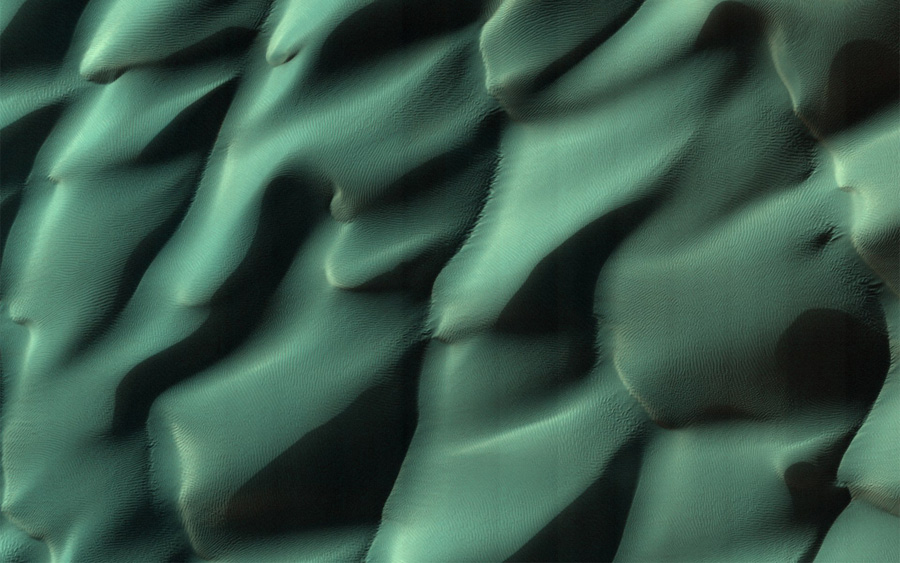
On Mars, the volcanic crater Nili Patera is being carefully studied, at the bottom of which sand dunes crawl. Their movement has been monitored for many years with the high resolution HiRise camera of the MRO satellite. The movement of sand dunes was found in other places of Mars.

Another interesting object to study are polar ice caps. The polar glaciers are perhaps the first objects on the surface of Mars that have been identified by humans. When astronomers saw the similarity of the poles of Earth and Mars, and then distinguished dark spots on the red sides of the planet, Mars seemed to be a complete copy of the Earth, and the idea of local residents was quite logical.
Initially, the polar caps of Mars were considered watercars , and their annual volatility gave rise to hypotheses about regular floods of meltwater, which superimposed on erroneous observations of the Martian "channels". However, already in the middle of the twentieth century, it was possible to establish that the main area of winter poles is covered by carbon dioxide ice, and water remains in small summer polar caps. Thanks to the MARSIS radar of the Mars Express satellite, it was possible to establish the thickness of polar water deposits: in the north - 1.7 km, in the south - up to 3 km. If you take the polar ice and melt, you get a completely flush with water 21 m high ideally smooth planet the size of Mars. Accordingly, if we melt these reserves, then we will be enough for a small ocean or several small seas of Mars.
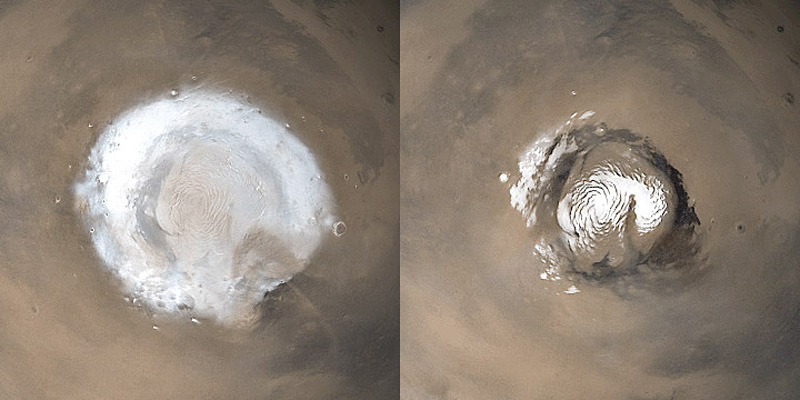
Studies of the surface of Mars indicate that there was more water before. There are empty river channels on the planet, river deltas, remnants of lakes, and there are even some signs of the former ocean, which occupied from a quarter to a third of the entire planet. The question of where the vast reserves of Martian water have gone has not yet had an exact answer, but there are two hypotheses: the first is that the water has gone into the ground, contacted minerals and formed glaciers; the second - water dissipated into space. Although more and more arguments tend to the second hypothesis, water on Mars is not only at the poles and in the polar region. The subsurface glaciers are defined in the northern hemisphere up to the 40th parallel to the equator - for the Earth it is the latitude of Sochi. There are deposits of ice east of the Hellas valley, and even at the equator, the water content is between 5% and 10% in the ground.

All this time we have been talking about water in the solid phase or in the bound state of aggregation. The atmospheric pressure of Mars does not contribute to the maintenance of water in the liquid phase: even in low-lying regions with the highest pressure, water boils away at +10 ° C, and given the seasonal variations in atmospheric density, as well as temperatures above +10 ° C on summer days, long-term water retention on the surface virtually eliminated. But recent studies of the CRISM hyperspectrometer and the HiRise camera have added arguments to the hypothesis that in the ground of Mars, it is possible to maintain water in a liquid state at minus temperatures in the form of brines of salts of perchloric acid.
Until recently, scientists could not give an affirmative answer to the question about the presence of organic compounds on Mars. The first data appeared during ground-based observations, when they determined the presence of methane in the atmosphere of Mars. To search for organics on the Red Planet went the rover Curiosity. His first data at the end of 2012 turned out to be encouraging, but then it turned out that an error had occurred and the rover "discovered" organic matter, which he himself had brought with him - the solvent tank was damaged for the wet analysis of the soil. A year later, when the device accumulated statistics on the study of different types of soil, it was possible to say more confidently - there is organic matter. Chlorobenzene was found.
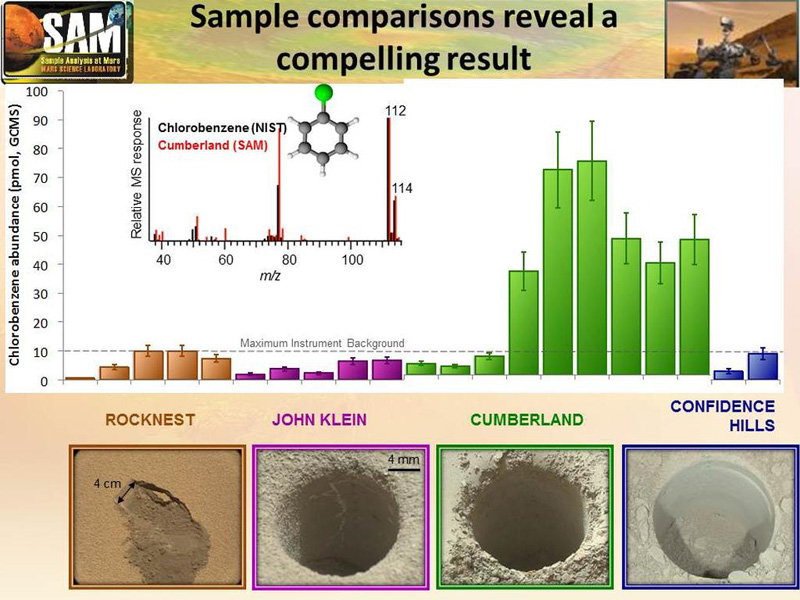
A year later, it was possible to confirm the appearance of methane in the atmosphere of Mars , although there is no definite opinion about the processes causing the release of this gas.
It should be noted that the found organic compounds are not a direct confirmation of the presence of biological activity of Mars in the past. Organic compounds are known on Mercury, on comets, asteroids, satellites of giant planets, in the atmosphere of giant planets themselves, and in other places of the near and far Universe. The biomarkers in organic compounds of Mars will be able to mission of the rover ExoMars, the launch of which is planned for 2020.
An important find in terms of possible past or future life is nitrates in some geological layers in the Gale crater. For the Earth, nitrates are considered fertilizer and are used for their intended purpose. For Mars, the nitrates found mean that in the past there were conditions that allowed us to develop life forms known to us, and this finding opens up prospects for future agriculture (more precisely, marsodeliya) and agriculture.
Analysis of the Mars soil by the SAM mass spectrometer onboard the Curiosity rover showed that when the soil heats up to +400 ° C, carbon dioxide, water vapor, oxygen and nitrogen are released, which is generally suitable for use in future human activities on Mars.
In the context of a manned flight to Mars, the issue of radiation hazard during flight and when operating on the surface is compulsory. Studies of radiation conditions during the flight to Mars and on its surface were carried out and carried out by the RAD instrument onboard the Curiosity rover.
The study of the effects of cosmic rays during the flight to Mars gave not very encouraging data: the risk for people is one and a half times more acceptable for astronauts, and for astronauts the tolerances are even stricter. On the surface, conditions are more acceptable. The impact of ionizing particles on the surface of Mars is approximately twice as low as in the conditions of space travel, and at low solar activity corresponds to the radiation background on board the International Space Station.
Obligatory stage of the study of Mars will be the delivery of soil samples to Earth. While this task is quite complex, but remains in the projects of NASA and Roskosmos. While there is the possibility of studying meteorites, which are believed to have arrived from Mars. In the 1990s, it was reported that fossils similar to bacteria were found in one of the meteorites, but most scientists disputed this hypothesis. Recently, curious petrified structures have been discovered in another meteorite .

Outwardly, the find resembles a cell in which vacuoles and even cell pores can be defined, however, this is a single case and there is too little evidence to report a sensation. One can only hope for more productive discoveries of current and future research missions.
Source: https://habr.com/ru/post/369555/
All Articles